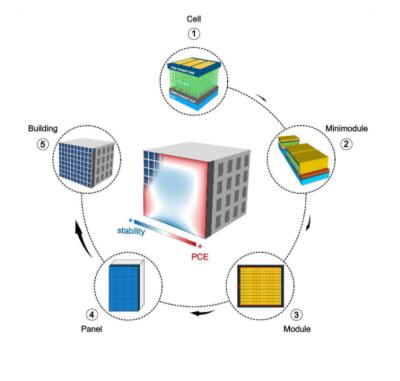Eindhoven University of Technology researchers have developed a multiscale computational framework for scaling up perovskite photovoltaics from cell scale to building integration.
The novel framework includes three key modeling components: (i) cell scale, incorporating a coupled optical-electrical-thermal model to characterize performance and hysteresis of small-area perovskite solar cells, (ii) module scale, designing monolithically interconnected perovskite minimodules and quantifying upscaling losses, and (iii) building scale, assessing complex interactions between environmental factors and building-integrated perovskite photovoltaics.
Comprehensive scale-based validations were performed to assess the accuracy and reliability of each modeling component. The application of the framework is illustrated for perovskite photovoltaics integrated into the windward façade of a cubic building. The results reveal significant variability in power conversion efficiency (PCE) and hysteresis across the façade due to spatial variations in wind-induced forced convective heat flux.
In this case, wind was found to impact both the ionic and electronic characteristics of perovskite solar cells, playing a double-edged role in building-integrated perovskite photovoltaics by enhancing PCE while inducing hysteresis. This wind-induced PCE enhancement originates at the interfaces, reducing recombination losses at the electron transport layer/perovskite interface and resistance to charge carrier transport at the perovskite/hole transport layer interface.
The investigation also highlighted that scaling up perovskite photovoltaics from small-area cells into monolithically interconnected minimodules is essential for advancing toward large-scale integration of perovskite solar cells into buildings.
The developed multiscale computational framework aims to support the advancement of building-integrated perovskite photovoltaics by addressing critical challenges in performance, stability, and scalability, ultimately contributing to the wider adoption of sustainable energy solutions in the built environment.




